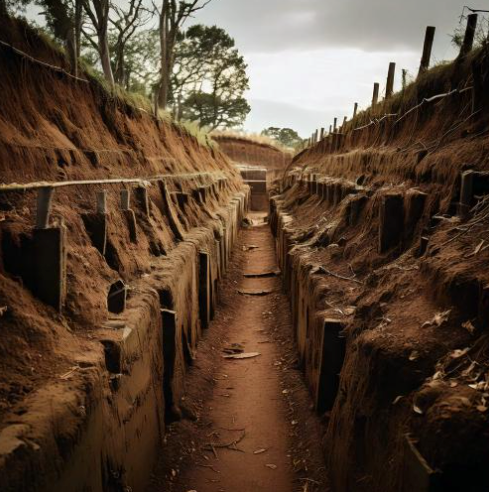Introduction
Utility construction is a vital part of modern infrastructure development, encompassing the installation, maintenance, and repair of essential services such as water, electricity, gas, and telecommunications. To ensure efficiency and safety, this field relies on advanced techniques and tools. Among these, trenching and ground-penetrating radar (GPR) play critical roles. This article explores the importance of utility construction, delving into these key methods and their applications.
What is Utility Construction?
Utility construction involves creating and maintaining systems that deliver utilities to homes, businesses, and industries. These systems include underground pipelines, cables, and conduits that enable essential services like:
- Water Supply and Wastewater Management
- Electricity Distribution
- Telecommunications Infrastructure
- Natural Gas Delivery
This field often requires working in various terrains, from urban landscapes to remote areas, making advanced planning and specialized tools essential. triplejconstructionandutilitiesllc.com has solid experience helping clear paths for utilities.
The Role of Trenching in Utility Construction
What is Trenching?
Trenching is the process of excavating narrow, deep channels in the ground to install underground utilities. It’s a foundational method in utility construction and is used to:
- Lay pipes and conduits for water, sewage, and gas.
- Install underground electrical cables.
- Create pathways for telecommunication lines.
Types of Trenching
- Open-Cut Trenching:
- A traditional method where a trench is fully excavated to install utilities.
- Suitable for new installations in open areas.
- Directional Trenching:
- Uses specialized equipment to minimize surface disruption.
- Ideal for urban settings or environmentally sensitive areas.
Equipment for Trenching
- Excavators: Heavy machinery for digging trenches quickly and accurately.
- Trenchers: Machines designed specifically for cutting narrow trenches.
- Hydro Excavators: Use pressurized water to excavate soil without damaging existing utilities.
Safety in Trenching
Trenching poses risks, including cave-ins and equipment-related injuries. To enhance safety:
- Use protective systems like trench boxes or shoring.
- Follow OSHA guidelines for trench construction.
- Conduct soil stability tests before excavation.
If you need trenching services be sure to look these guys up.
Ground-Penetrating Radar (GPR): A Modern Solution
What is Ground-Penetrating Radar?
GPR is a non-invasive technology that uses electromagnetic waves to detect subsurface objects. It’s a game-changer in utility construction, offering a precise method for locating underground utilities without excavation.
Applications of GPR in Utility Construction
- Utility Mapping:
- Identifies the exact location of pipes, cables, and conduits.
- Prevents accidental damage during excavation.
- Soil Analysis:
- Assesses ground conditions for trenching or other construction activities.
- Detecting Obstacles:
- Locates buried objects like rocks, tanks, or abandoned lines that could impede construction.
Advantages of Using Ground Penetrating Radar
- Accuracy: Provides detailed imagery of underground utilities.
- Non-Destructive: Avoids unnecessary digging, preserving the site’s integrity.
- Time Efficiency: Reduces delays caused by manual utility detection.
- Environmental Safety: Minimizes the risk of disturbing fragile ecosystems.
How GPR Works
- A transmitter emits electromagnetic waves into the ground.
- Waves reflect back to the GPR device when they encounter objects or materials.
- Reflected signals are analyzed to create a subsurface map.
Combining Trenching and GPR for Optimal Results
Trenching and GPR are often used together to improve utility construction efficiency:
- Pre-Trenching Surveys:
- GPR maps out underground utilities to guide trenching operations.
- Avoiding Hazards:
- Identifying and avoiding existing utilities reduces accidents and costs.
- Precision Installation:
- Ensures trenches are excavated in the correct locations, minimizing rework.
By integrating these methods, utility construction projects achieve better safety, efficiency, and environmental stewardship.
Challenges in Utility Construction
Despite advancements like GPR, utility construction faces challenges:
- Complex Underground Networks: Older systems may lack accurate maps, complicating new installations.
- Regulatory Compliance: Adhering to safety and environmental standards can be demanding.
- Cost Management: Advanced tools and techniques like GPR require investment.
To overcome these, many companies adopt innovative technologies and prioritize workforce training.
Frequently Asked Questions (FAQs)
1. Why is trenching important in utility construction?
Trenching is essential for creating pathways to install or repair underground utilities, ensuring efficient and safe service delivery.
2. What are the risks of trenching?
Trenching risks include cave-ins, equipment accidents, and damage to existing utilities. Proper planning and safety measures mitigate these risks.
3. How does GPR improve utility construction?
GPR accurately locates underground utilities and obstacles, preventing accidental damage and reducing excavation costs.
4. Can GPR detect all underground utilities?
While GPR is highly effective, its accuracy depends on soil conditions and the materials of the utilities being detected (e.g., metallic vs. non-metallic).
5. Is GPR expensive to use?
While GPR equipment can be costly, its efficiency and accuracy often offset expenses by reducing project delays and damage.
6. Can trenching and GPR be used for residential projects?
Yes, these techniques are scalable and can be adapted for residential utility installations and repairs.
Conclusion
Utility construction relies on advanced methods like trenching and ground-penetrating radar to deliver essential services efficiently and safely. Trenching provides the physical pathways needed for installations, while GPR ensures accuracy and minimizes risks. Together, these techniques revolutionize utility construction, making it more precise, cost-effective, and environmentally friendly. Whether for large-scale infrastructure or residential projects, these tools are indispensable in shaping our modern world.


